So I had a strange and unexpected thing happen this week. As is typical, I’ve gotten a bunch of new subscribers during the course of the week—and thank you all for being here! But there was also one new subscription that came in that kind of knocked me on my backside. Because that one came along with a pledge to pay $8.00 a month for the privilege of reading my ramblings. If I’m honest, it kind of messed me up a little bit, as I’ve never considered this Newsletter as a profit-generating source before—hence its motto: Always Free, Occasionally Interesting. But now I can hold my head up high and move forward with certainty that at least one person would slip me eight bucks a month in order to read it! So thanks for that—and if you’re really serious, then the best thing to do with that eight dollars would be to donate it to the Hero Initiative, so that they can continue to do their good work on behalf of comic creators who are down on their luck. And for anybody else who might like to do likewise, you can use this handy link here.
Anyway, it’s time to get things rolling this week, beginning with a question from Zack:
I've been thinking a lot about the idea of IP going "back to basics". There's hundreds of comics about the 90s X-Men (for example) living at the school battling Magneto. Not to mention a ton of adaptations playing with the same idea. Do you see value in stories that reinforce the classic paradigm for these pieces of IP?
I think the bigger question I'm asking is where should Marvel Comics be looking? Backwards or always into something new and different?
I look at the MCU adapting stories and characters from the last decade and wonder how editorial views their role in reloading their story arsenal vs doing another story where Spider-Man is worried about the fall out of the Clone Saga.
I think there are a couple of different questions there, Zack, so let me try to hit them all. First off, there is definitely a gravity that gets exerted on long-running strips in terms of there being certain immutable underlying principles that tend to reassert themselves over time. One has to look no further than all of the recent stories concerning Superman getting his secret identity restored, when it was only revealed to the world a few years ago. And I don’t know that this is necessarily a good thing or a bad thing rather than simply being a thing that is. Certainly, in some instances, a change to a popular franchise has stuck, and become a part of the new, revised formula. Reed Richards and Sue Storm getting married, for example, or the All-New, All-Different X-Men joining that team. I think stories in general should be attempting to push these characters and concepts forward as much as they reasonably can. But I also see the value in not losing the baby along with the bathwater, and there are times when restoring some aspect of the classic set-up has value to it. For myself, while I was interested in Clark Kent revealing his truth to the world, I also see the elemental necessity for Superman to maintain a secret human identity. So the fact that they’re going back to that set-up doesn’t trouble me (and if I were in their shoes, I might be doing the same thing.) For Marvel Comics as a whole, I think we should be looking to tell the most interesting stories that we can, and to remain as the tip of the spear so to speak, staying ahead of what everybody else is doing with the characters in other media. That’s where our real value as storytellers lies. I recently listened to a podcast where Gerry Conway opined that we should shut down the existing Marvel Universe and instead mirror more closely what is being done in the films, since that’s the versions of these characters that everybody knows. No disrespect to Gerry, but I think he’s utterly wrong about that. The surest way to extinction for the Marvel Universe would be for it to become subservient to the needs of another form. As C.B. Cebulski likes to say, the comic are the heart in the body that is Marvel which pumps the blood to all other areas/divisions and which takes back in everything that they come up with in some regard.
And one from JV:
Question on 'genre' comics - any particular non superhero genre you enjoy and/or think Marvel should explore?
I love the sword and sorcery genre - I think Marvel's recent handling of the Conan franchise was fun - amazing reprints, new stories in the Hyborian age and some Marvel team ups.
Ed Brubaker's crime focused comics are also some of my favs these days.
I tend to like certain comics in a myriad of genres, but I don’t know that there’s any particular genre that I feel strongly about Marvel trying to do more of. For me, it more comes down to the specifics of just what is being pitched rather than some larger feeling that we need more westerns, more romances, more war comics, or what-have-you. I’d welcome any of those things if the stories were good, but I also am aware that genre fiction tends to be a difficult sell at the big two, at least as compared to the super hero universe material. So I’d want to make sure that we had something worth standing behind before we moved ahead with it, if that makes sense.
Glen Cadigan asks:
Your mention of working remotely and how it's allowed you to catch up on sleep reminded me of how, back when he was head writer/head editor/head everything, Stan Lee convinced Martin Goodman to let him work from home one day a week so he could actually write the comics Marvel was publishing. After a while, Stan asked if he could up that number to two. Martin said yes. Then Stan decided to push his luck and ask for a third day off. If I'm remembering right, he got it, which leads to an actual question: is that the sort of hybrid home/work schedule you see Marvel eventually resuming? Maybe first one day a week in the office, then two, then three, etc.? Like Stan, people have proven they can get a lot of work done from home, and a happy employee is a productive employee.
I really can’t say at this point, Glen, what a return to the office might look like for Marvel. While I could hazard some guesses—such as that it’s unlikely that everybody will be called upon to be in the office every single day—I realize that there are certain intangibles to having the entire staff in one place that aren’t easily duplicated when the crew is working remotely. A lot of that is just the osmosis of the spirit of the place, and the values that define it. And also, a sense of personal interactions. There are now some young editors who have been on staff for something like 18 months whom I have never met in person. But in the same way that I couldn’t possibly predict how the Covid situation will develop next, so too can’t I really say what a return to office life for Marvel will look like.
And one from John Cassillo:
So when it comes to new creative runs for books like the Avengers or Amazing Spider-Man, does Marvel first reach out to its existing writers to solicit pitches? Or does it just ask specific writers for pitches or treatments against an existing idea from editors and go from there? Or a mix of both? Just figured for something like Avengers or ASM, there’s probably more demand for a longer story-telling plan than other titles. But maybe I’m wrong there.
I feel as though this is something that I’ve addressed in the past, but maybe I haven’t hit on exactly what you’re asking about, John. When a series such as AVENGERS or AMAZING SPIDER-MAN opens up, the editor in question, typically in conversation with the Editor in Chief, works out whom they might like to reach out to based on where the series is and what they think it next needs. Sometimes that’s a writer already working at Marvel on other stuff, and sometimes, that’s somebody from outside Marvel who is working on other things. Depends entirely on the specific timing and circumstances. It’s also not unheard of to ask two or three writers for their ideas for what they might do with the series were they to take it over in those instances where there isn’t an obvious front runner favorite for the assignment. In those cases, though, it’s imperative that everybody involved understands the situation and the fact that other people are simultaneously being spoken to. But we don’t typically make it an open cattle call to writers, either among the folks who are already working for us or in general. Some of that is due to the fact that, for legal reasons, Marvel doesn’t accept any unsolicited submissions.
Y. Lu had this question:
Do you think being an editor, working behind the scenes so long, has altered your own taste in comics? I imagine this might not be easy to answer since your tastes would change over time anyway even if you weren't in the business, so it might be difficult to separate what's just the passage of time and what's born of the behind-the-scenes perspective. But are there, for example, certain things you now appreciate more because you realize how hard they are to achieve for creators?
I’m sure that it must have, but as you mention, Y., because it’s been happening subconsciously, I don’t know that I’m aware enough about it to be able to point to something in specific.
Elias Rosner sent over a question from out of left field:
Entirely unrelated to comics question! I was watching the Project A-Ko bluray and there was a special feature about an unreleased CDRom game. At the end of the feature, the original credits for it came up and I was shocked to see your name as a co-writer on the game! Is this truly you? And if so, how the heck did that happen??
Yes, that was me, Elias, though I haven’t thought about it for a very long time. As for how that happened, it was pretty simple: the firm that had been hired to create that game had been co-founded by a pair of guys that I had known for years through early Anime fandom, Mike Pinto and Brian Cirulnick. They needed somebody who would know the material and who could write, and they were aware that I and my writing partner of the time Mike Kanterovich had been working for Marvel. So they reached out and got us on board to do it. And as that disk says, the project never came to fruition, though we made a few dollars on the work we did, so that was all right.
More in the immediate wheelhouse, Graham wondered:
I can’t remember if you’ve addressed this before but I was wondering about the editor in chief role. Is that something you’ve ever wanted to tackle? What have your relationships with the various people who have held that position at Marvel been like while you’ve been there?
I’ve said before, many times, that the Editor in Chief position is something that you pretty much have to take if they offer it to you, if only defensively. Because if you turn it down, then whoever winds up taking the job on is going to be aware that you were in line for it ahead of them, and that’s likely to cause problems. But honestly, while I did once tell Tom DeFalco that I was angling for his job early on, while he was the EIC, I’ve since realized that it isn’t really something that I want to do. The EIC seems like a crucial position, and it is, but it’s a position that’s also difficult to navigate. Everybody works for somebody, and while some seem to think that being the EIC is a license to do whatever you want, the reality is that there’s still a larger structure in place to which you are beholden—objectives, both financial and creative that must be met, and so forth. And the buck stops with you on all things. For me, though, the real issue with being EIC is that the Editor in Chief doesn’t actually directly edit any comics. They have broad powers over all of them, but they don’t ever get to get their hands inside the engine in a real tangible fashion. And as that’s the part I like to do, I suspect that I’d be highly frustrated were I to be fulfilling the EIC role. And in answer to the second part of your question, while they have all frustrated me at one point or another, I feel like I’ve gotten along well with all of the six Editors In Chief under whom I’ve worked—Tom DeFalco, Bob Budiansky, Bob Harras, Joe Quesada, Axel Alonso and today C.B. Cebulski. (That’s another downside of the EIC job: it comes with an expiration date, though you never know what it is. I’d like to be doing this job for a good long time to come still.)
And finally, one last query from Clive Reston:
Do you have a sense of how abrupt the decision to cancel the original Silver Surfer series was? I know that Herb Trimpe was supposed to start drawing the series with #19; do you have any idea if Trimpe drew anything beyond the cover of #18? (It's always seemed odd that the series ended with a full-on cliffhanger, since I don't think Marvel had done that before! And I get the sense--you may know differently--that creators tended to work pretty far ahead of print deadlines in those days.)
Cancellations used to happen pretty quickly in those days, Clive, as Marvel’s publisher Martin Goodman could occasionally be quick on the trigger. And it’s clear, looking back at it, that SILVER SURFER had been struggling as a series for some time. This is why it was reduced from a double-sized 25 cent book to the regular 15 cent format. To the best of my knowledge, no work was ever begun on SILVER SURFER #19—I’ve seen no unfinished pages from Herb Trimpe, nor have they turned up anywhere in any other stories, repurposed. So if Herb had started drawing #19, he clearly didn’t get very far, and was likely not paid for that work.
Behind the Curtain
I’ve mentioned in previous installments how there are occasionally covers commissioned that don’t get used for one reason or another. What I’ve got to share with you today is one of those, though it’s a bit different from other covers that fit into this category.
.The above cover image was commissioned by editor Steve Wacker for AMAZING SPIDER-MAN. I believe it was generated for an anniversary or centennial issue, though I could be wrong about that. And rather than being meant to be a main cover, it was instead intended to be part of a comedic feature showcasing covers that had never appeared in the series. The artist was Mike McKone, who did a numbe3r of AMAZING SPIDER-MAN covers during that three-times-a-month period. The whole thing was a take-off on one of the best-remembered moments of the 1970s, the storyline in which Spidey’s Aunt May almost got married to Doctor Octopus. (“With This Ring, I Thee Web.”) In this case, though, once the piece was completed, somebody got worried that, even in a comedy feature, the image could be taken out of context and used to gin up trouble, and so the piece was spiked. That’s Steve Wacker himself as Spidey’s best man, and pretty much everybody on the web-slinger’s side of the church is a Marvel staff member of that period, including Jeanine Schaefer, David Bogart, Joe Quesada, Tom Brennan, and me. The final piece was intended to have balloons from Aunt May in which she’d be objecting to this union, but they never got lettered or written so far as I know.
Pimp My Wednesday
The middle of the week can’t come soon enough, am I right?
Now, this one’s a project that has been in the pipeline for a very long time—since at least 2019. It was interrupted and taken off schedule during the lockdown, but we’ve finally got everything in place and completed and ready to go. AVENGERS: WAR ACROSS TIME is a five-issue limited series (with an oversized first issue that started life as two regular-sized issues) written by former DC President Paul Levitz, making his Marvel writing debut after a career spent working for the competition. The artwork was done by Alan Davis in what is likely his last regular assignment prior to his retirement from the business. And as it seems, it’s a love letter to the very earliest days of Earth’s Mightiest Heroes and to the Silver Age Marvel Universe into which it was birthed. Kang is the main antagonist for the storyline, though there are other menaces the Avengers will need to contend with along the way, some familiar, some obscure. It should be a whole lot of fun.
No, that isn’t a doorman beating up on MOON KNIGHT on this cover. Rather, it’s an obscure villain from teh Crescent Crusader’s past; Commodore Donny Planet. No need to ask yourself, “Who…?” or look him up on-line, writer Jed MacKay has you covered here. And with Federico Sabbatini backing him up on visuals, this issue will set the stage for what Moon Knight will be dealing with across the next couple of months.
And 67 years in the future, things aren’t looking so good for our oddball collection of misfits and maniacs, as they’ve all been killed by Ultron and resurrected as fearsome Deathloks. Only Jake Gallows, the Punisher of 2099 and the Miles Morales Deathlok remain to put things aright—well, if you don’t count writer David Pepose and artist Carlos Magno. Pick up SAVAGE AVENGERS #9 to see how they all do!
And Associate Editor Annalise Bissa along with writer Eve L.Ewing and artists Luca Maresca and Ivan Fiorelli bring you the second issue of MONICA RAMBEAU: PHOTON, in which the title character finds herself among familiar faces in strange circumstances. What’s going on? There’s only one way to find out!
And finally, on MARVEL UNLIMITED, the third installment of “Key To A Mystery” drops in the AVENGERS track, as Earth’s Mightiest Heroes come together to get to teh bottom of the strange figures who have been materializing to attack them. The trail takes them to a locale familiar to longtime readers, thanks to writer Jim Zub and artist Caio Majado
A Comic Book On Sale 80 Years Ago Today, January 8, 1943
It’s been getting tougher to find books of note that have been released on the dates in question as we’ve traversed the holiday months. Hopefully this will get easier in the future. But this week’s entry gives me the opportunity to talk about one of my favorite forgotten strips of the Golden Age of Comics. This is SUPERSNIPE, whose 8th issue came out on this date eighty years ago. Supersnipe was the creation of cartoonist George Marcoux, and as the name implies, it wasn’t really a super hero series at all. Rather, it concerned the small town adventures of Koppy McFad, a fellow with the unique claim of owning the most comic books in America. So affected is he by their bad influence that he routinely makes off with his father’s lodge cape, dresses up in red longjohns and a domino mask, and heads out into his neighborhood to right wrongs. Supersnipe started out as a secondary feature, a back-up in THE SHADOW COMICS, but he swiftly proved popular enough to headline his own title, one he kept for many years. It was less a straight out parody than it was an Our Gang style of series with a super hero overlay, and it was very charming. I wrote about the strip a bit more at length over at my website here, for anyone who’s interested. Most SUPERSNIPE covers followed the pattern of this one. They depicted some image of outrageous action, only revealing in the lower corner that the whole affair was taking place in Koppy’s imagination. This one’s got the almost pre-requisite nasty caricatures of the leaders of teh Axis nations with whom the U.S. was at war, a cause that many a comic magazine proved to be popular and profitable.
A Comic I Worked On That Came Out On This Date
AVENGERS WORLD #1 was released on January 8, 2014, and was intended to function as a sister title to the main AVENGERS series that was then being written by Jonathan Hickman. Jonathan was already well into setting up all of the building blocks he’d need for the upcoming SECRET WARS saga that we were building toward, so much so that the actual adventures of the Avengers were getting a little bit lost along the way. But really, this series was created as a vehicle for writer Nick Spencer. Nick had come over to Marvel having worked at DC and Image on a number of projects, but he’d clashed with some editors along the way, and his future was looking a bit shaky. As Jonathan was a friend of Nick’s, he suggested to me that we build this series and he would work on it with Nick—-much in the way that Brian Michael Bendis had brough Jonathan on to write SECRET WARRIORS some time earlier. It was clear to both of us that Jonathan would only be doing nominal work on the opening issues so as to get things started before he’d turn the entire affair over to Spencer to handle solo. What I remember here is that Nick and I had worked out a structure in which the first dozen issues of the book would be divided cleanly into three stories of four issues apiece. However, within an issue or two, AVENGERS WORLD became another one of those titles that I had to hand off to others to edit, and so that structure went by the wayside in practice. (In fairness, it might have still done so had I been editing the series.) On the artistic side, I brought in Stefano Caselli to launch the series, as he’d been working on and around the main AVENGERS title for some time, and I always enjoyed his work. This wasn’t the first time that I’d use him on an assignment like this. The other weird wrinkle to this first issue was that it was launched during a month where we were doing a weird promotional stunt around Deadpool. In essence, we produced a series of variant versions of the main covers to a number of our regular titles that had Deadpool horning in on the image.
Another Comic I Worked On That Came Out On This Date
MARVELS X #1 was first released on January 8, 2020. It was commissioned during a concentrated push that we were giving to the anniversary of Kurt Busiek and Alex Ross’s seminal series MARVELS, but it was really a prequel to a different Alex Ross project, EARTH X, which he’d done with Jim Krueger and John Paul Leon. But that MARVELS title meant that we needed to find a way to justify the story fitting into the aesthetic of that series as well, which was about seeing a ground’s eye view of the super heroics of the Marvel Universe. This we did by producing a story about a young boy who seemingly doesn’t receive any super-powers in the outbreak of mutation that was the inciting incident for EARTH X. Left on his own after his immediate family either dies or leaves, our lead character David has to make his way to New York City, where most of the super heroes live. A huge fan of the Marvels, David is sure that they can still save the world and return things to normal. The artwork was provided by Well-Bee, an artist who had previously worked with Jim on a creator-owned project, and whose chiaroscuro style was similar enough to that of John Paul’s to make a connection. (Well-Bee is a pen name, in case that isn’t obvious.) Unfortunately, the pandemic lockdown interrupted the release schedule of MARVELS X, and it kind of flew underneath the radar—people had other things they were thinking about, obviously. Which is too bad, as it actually all came together quite nicely. I’m deliberately not revealing the punch line to the adventure and how it connects to EARTH X so that you can experience it yourself.
Monofocus
While I was away over the holidays visiting friends, I had the opportunity to revisit a favorite show of mine, TOKUSATSU GAGAGA, which is about a young office lady who is secretly a closeted otaku fan of live action Japanese super hero shows. Inspired by this, I turned my attention to another similar series that I had missed when it was airing regularly. That was UNOFFICIAL SENTAI AKIBARANGER, which plows some similar fields but which is completely different. Co-produced by Toei, the makers of the actual Super Sentai series of life action kids team shows (the ones whose fight footage is routinely scavenged for use in the assorted POWER RANGERS shows), AKIBARANGER is a late night send-up series, albeit one that becomes absurdly meta. the show is about a trio of misfits who hang out in Akihabara, the Otaku mecca of Japan, and who are recruited into a program that turns them into actual transforming heroes (albeit unofficial ones.) Except that the whole thing is actually a delusion that takes place within their minds as they punch and kick at nothing in the real world. But the show gets even screwier as it goes along, as the threats begin to materialize in the real world, where the heroes can’t transform. Eventually, the main character realizes that they are all trapped in a TV show called UNOFFICIAL SENTAI AKIBARANGER and that its creator is attempting to end the series early because they’ve discovered this. They even ultimately wage a pitched battle against the THE END card that’s supposed to come up to signal the conclusion of the series. The whole thing is really wild, though it works best if you have some familiarity with the source material. And it definitely skews just a little bit more adult than a genuine Sentai series (So much so that the next episode narration consistently tells us that “Good Boys And Girls Should Not Watch!) Anyway, there’s a second season as well, which I’m just beginning to crack into. As a small taste, here’s the obligatory title sequence.
Slightly more locally, I was delighted to see that a second season of OLD ENOUGH had dropped on Netflix. This is a long-running feature in Japan in which incredibly young children—some under the age of three!—are sent to perform errands for their parents which usually require them to travel long distances alone and to cross heavily trafficked street and interact with service people of all sorts. I find it to be, no joke, the scariest program that I’ve ever seen, for all that the kids are clearly constantly being followed by the crew that’s filming them, and so aren’t entirely on their own. But it’s still terrifying, especially if you have any children of your own. In this second season, an additional wrinkle has been added. As I mentioned, this feature has been running for decades in Japan, and so on most of the new episodes we get a present day check-in with the now grown-up kids, some of whom have children themselves (at least one of which is put to the task of performing a similar errand in the present day.) The episodes are also all relatively short, between ten and twenty minutes, so they make for good popcorn viewing when you need something fast to entertain you for a few minutes.
Finally, just as the new GUNDAM series THE WITCH FROM MERCURY is finishing up its first cour and going on hiatus for a couple of months, Bandai has begun to release episodes subtitled to its official Gundam YouTube channel, at a rate of one a week. So there’s really no excuse for not sampling what has unexpectedly turned out to be my favorite GUNDAM series in many years. The first two episodes are there now, as is the Prologue—I’ve been advising people to begin with the first episode rather than the Prologue as it isn’t really indicative of the tone and flavor of the series as a whole, for all that it’s got a bunch of essential backstory in it. But you can watch it after episodes 1 and 2 and not really miss out on anything. Anyway, the link to hit would be this one. It also gives me an excuse to share with you this drawing of lead character Suletta Mercury that artist Philip Tan sent me when he discovered that we were both fans of the show.
Posted at TomBrevoort.com
Yesterday, I posted a piece about the forgotten nihilistic Jack Cole comedy series Death Patrol, which appeared in MILITARY COMICS.
And five years ago, I wrote about this issue of DC SPECIAL featuring Danger: Dinosaurs At Large, starring Captain Comet and Tommy Tomorrow!
And that’s the ballgame! Scrape together your eight dollars and we’ll meet back here in seven days’ time! (But Good Boys and Girls Shouldn’t Read!) In the meanwhile, be good!
Tom B

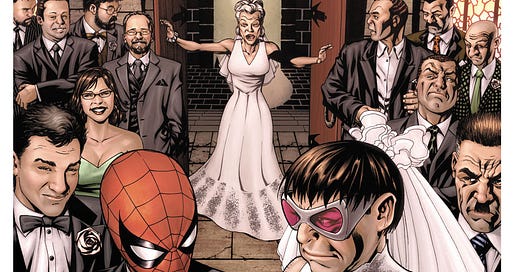



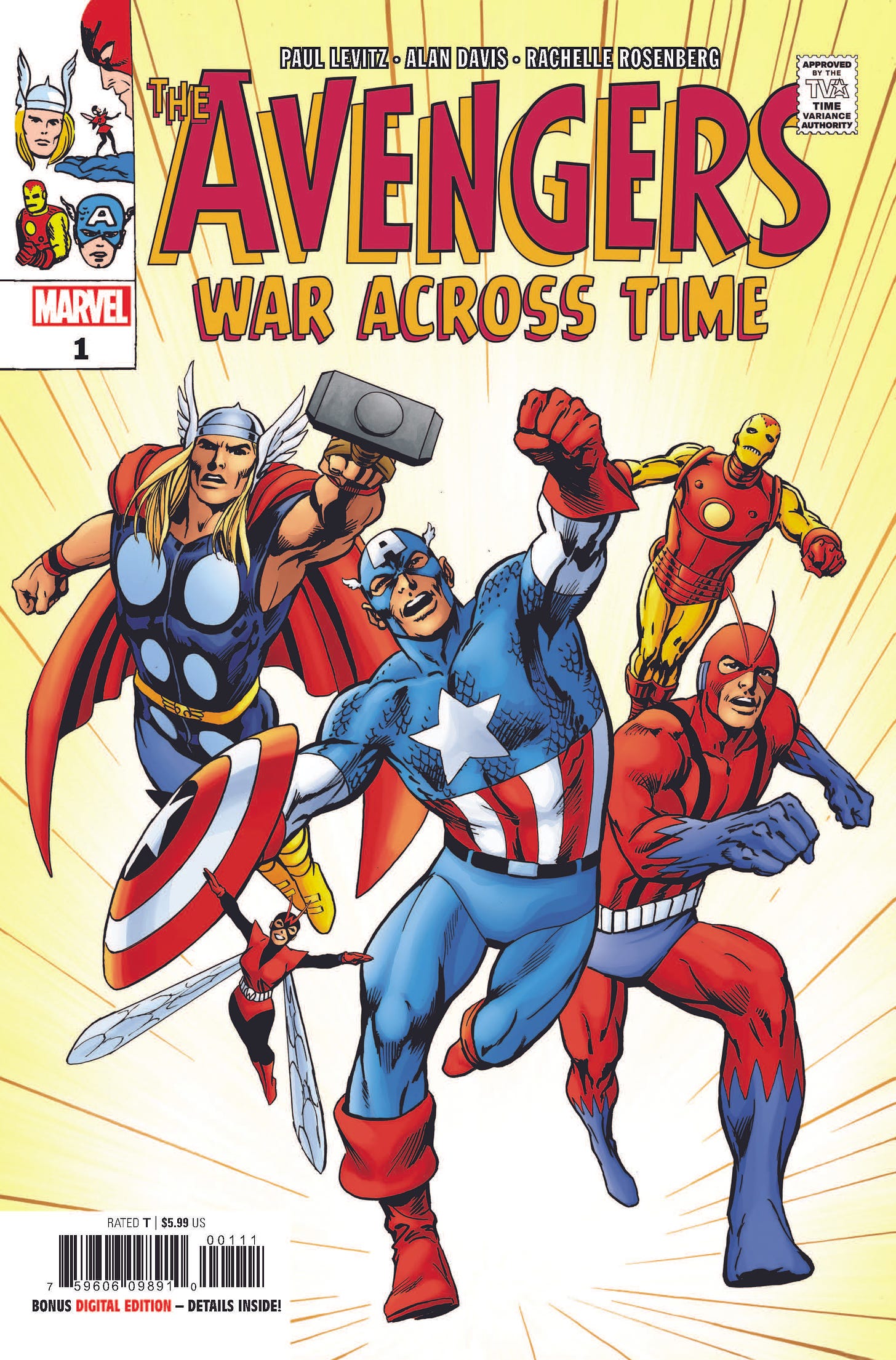
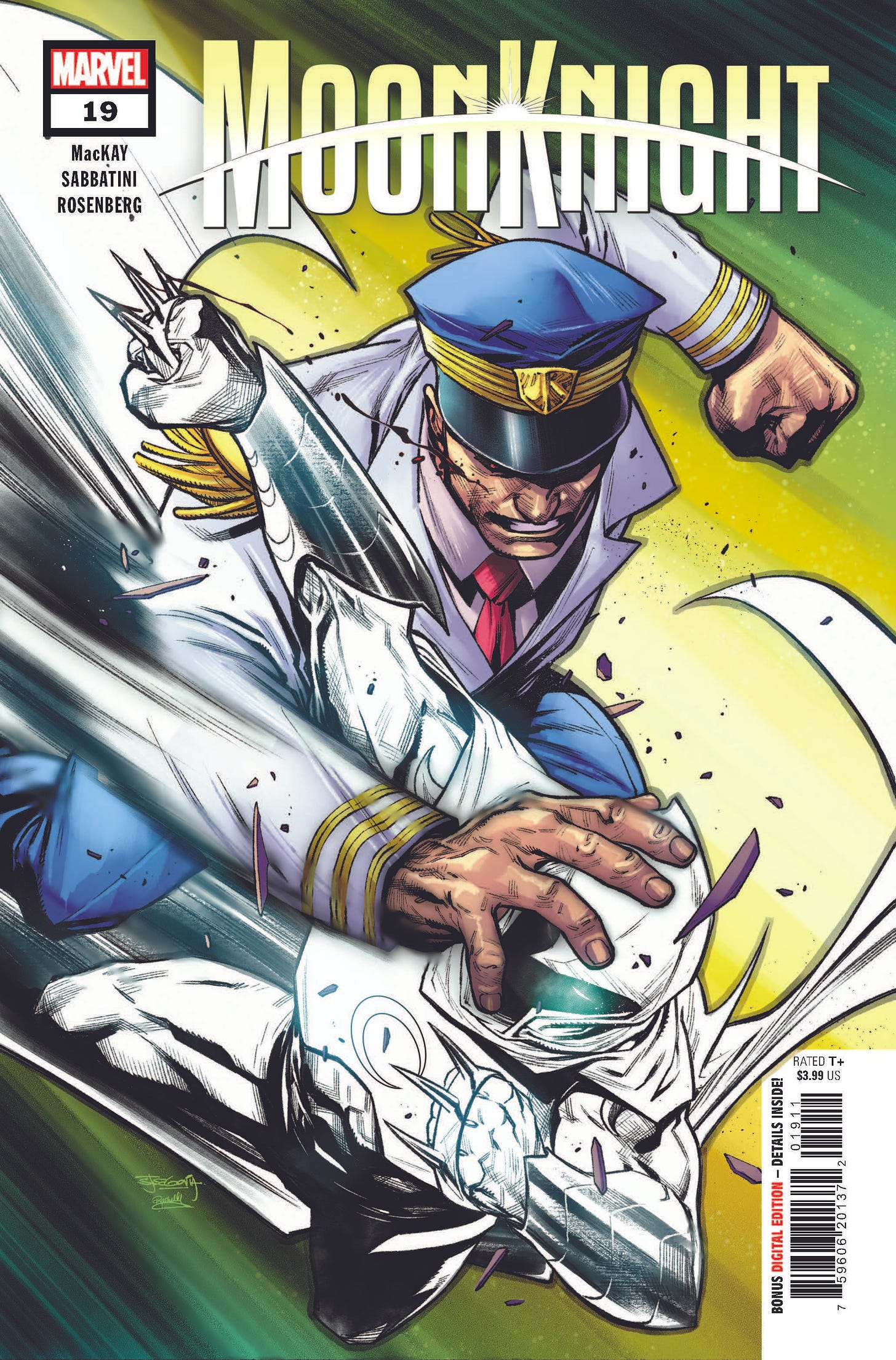

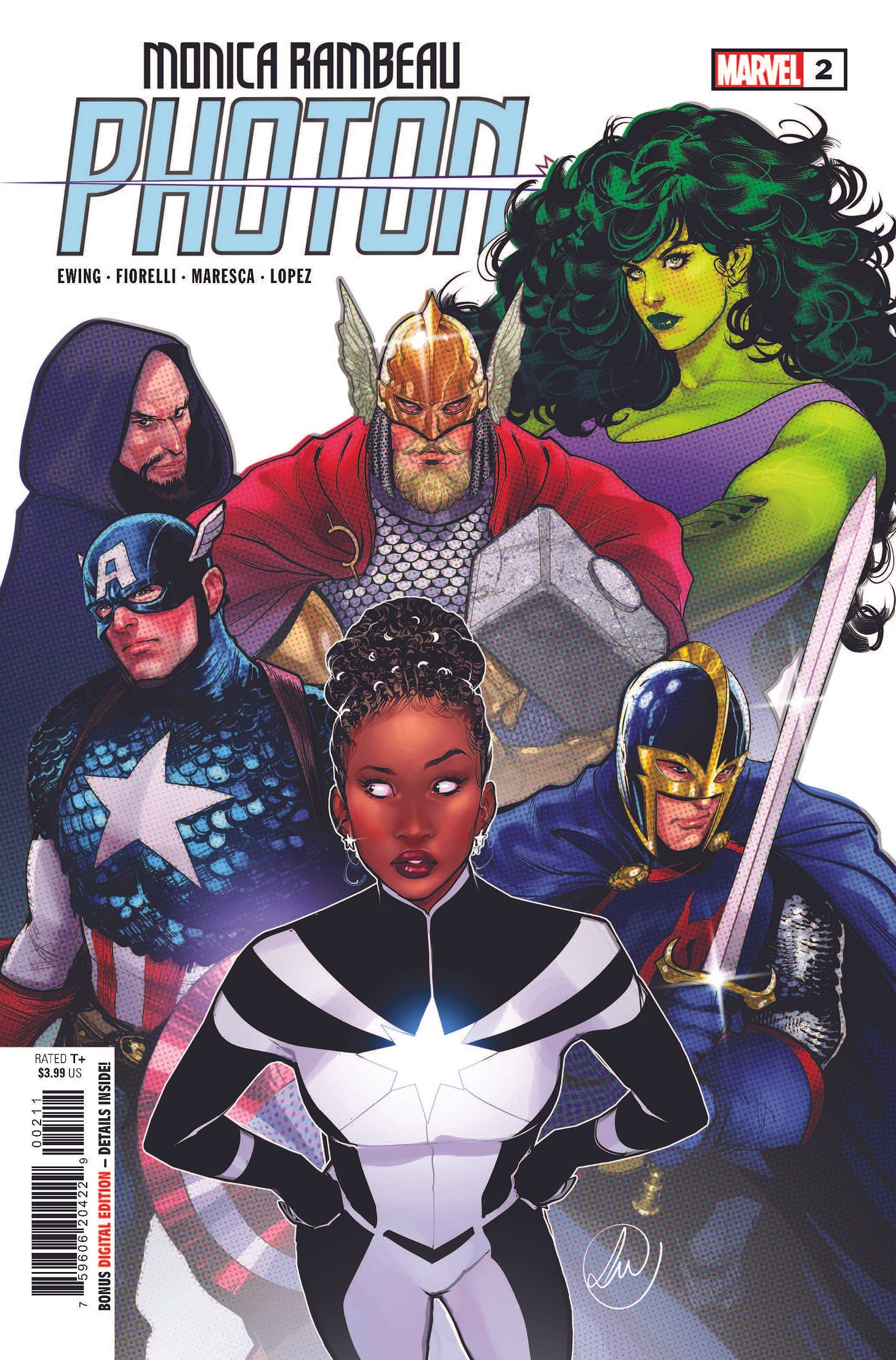
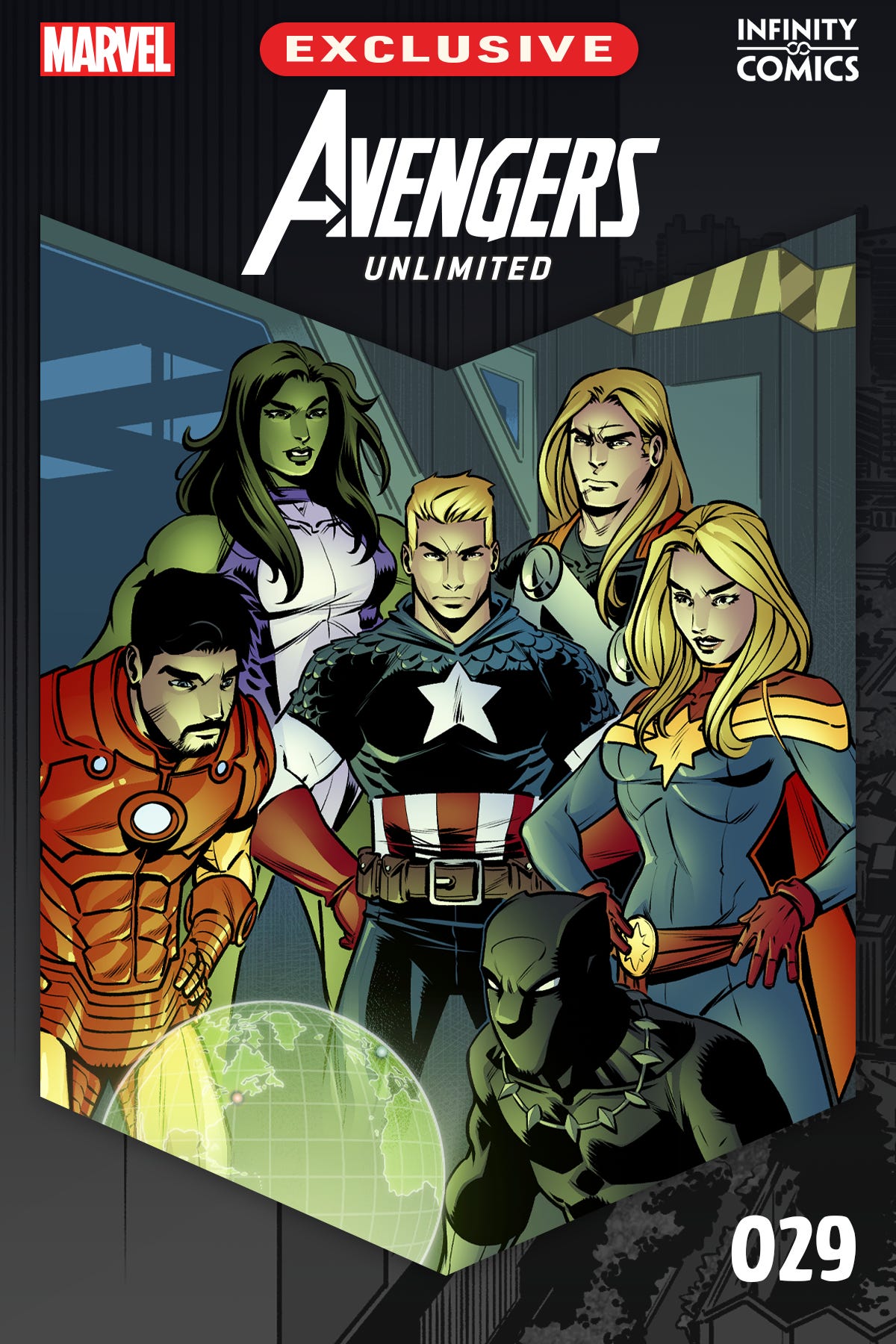
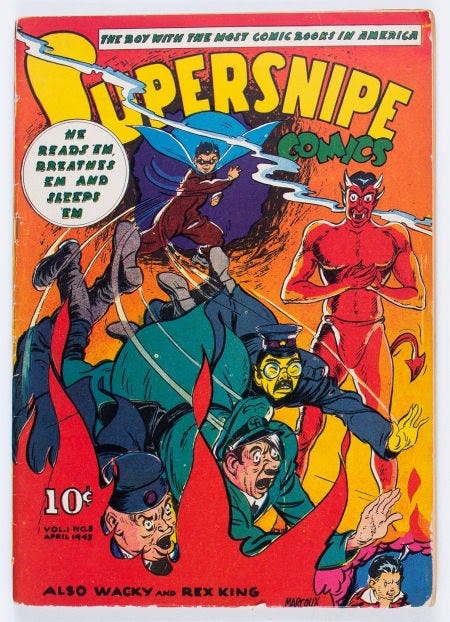
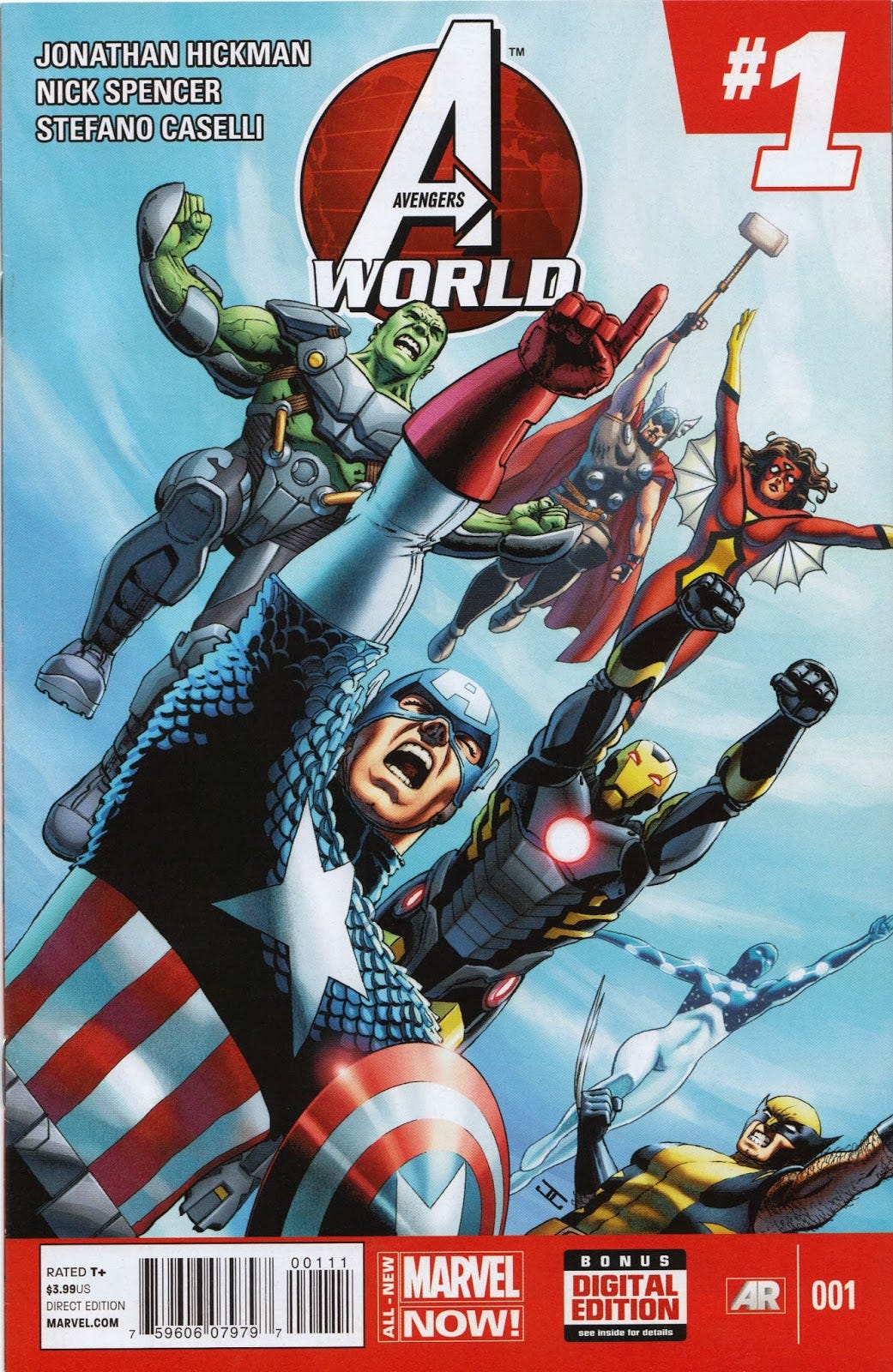
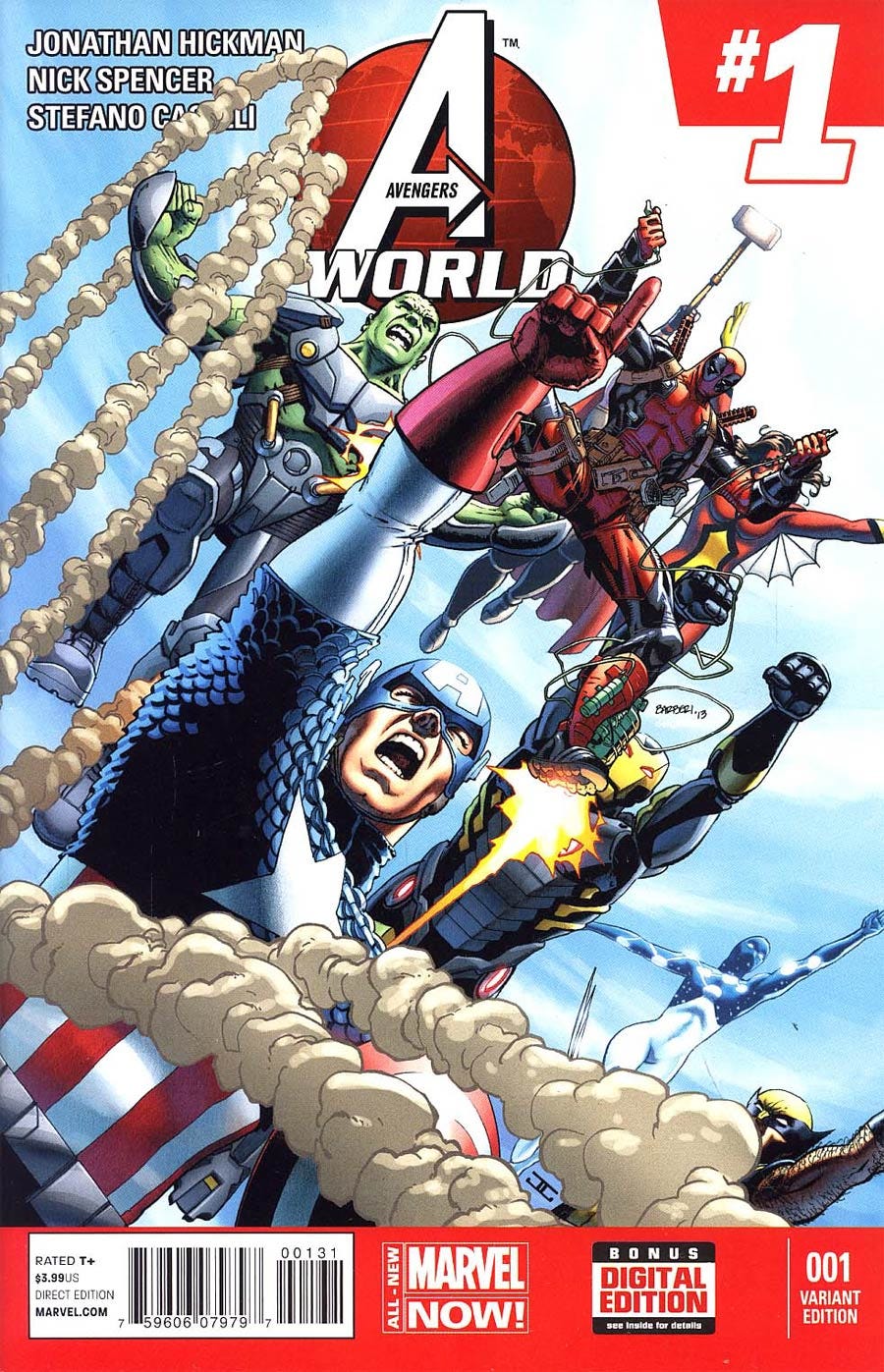


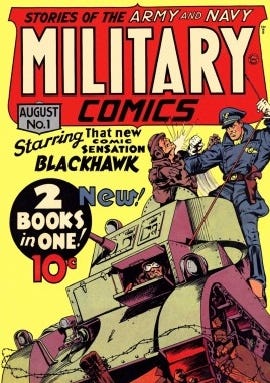
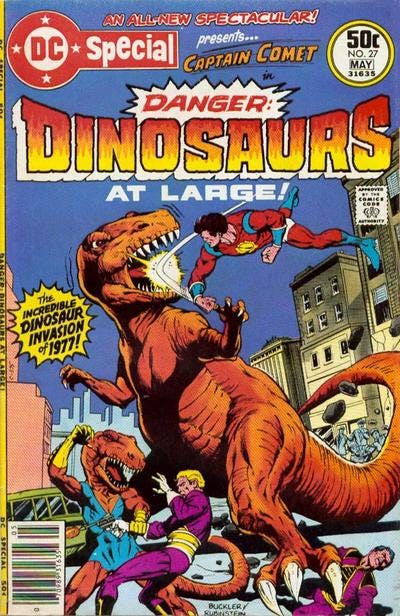
Thank for this newsletter, Tom!
Here is a question I have...
As a longtime comic book fan, what do you look for in a comic shop? And do you get a chance to vist any when you travel?
Thanks! Patrick Brower (Challengers Comics + Conversation in Chicago)
Late to the party here, but that Spidey "cover" was for a feature we did in ASM #600 called "Spider-Man Covers You'll Never See" that was a nod to the classic "What If...?" #34
I know Bendis and Loeb each contributed a gag as well, but I can't recall who came up with this one in particular. However, McKone drew the hell out of it. (I generally hated being drawn into books, but I've never looked better!)
While it was intended as a Bugs Bunny/Elmer Fudd style gag, Gay Marriage became a hot button political issue in the midst of putting the comic together. So there was a reasonable fear it would look like we were making fun of something that actually mattered or making some kind of obscure statement. The page was therefore spiked (which makes sense in hindsight, though I was bummed at the time since it's so funny.)
Also I have every issue of Captain Comet! Marvel TV was sick of hearing me pitch it as a TV series a few years back.